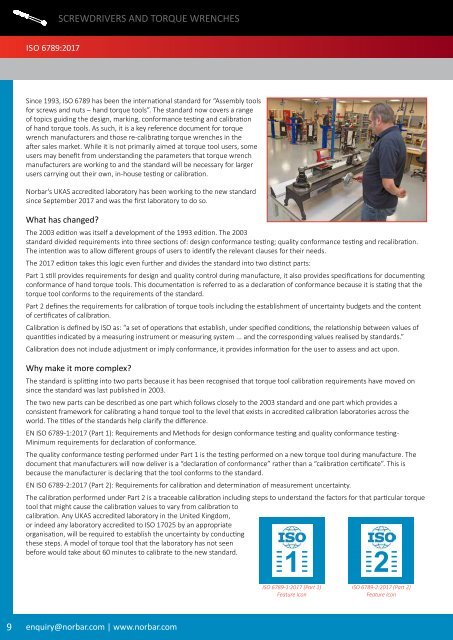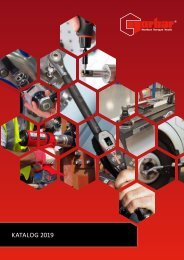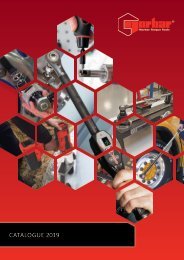Norbar Catalogue 2019
Torque Tool and equipment catalogue from Norbar Torque Tools
Torque Tool and equipment catalogue from Norbar Torque Tools
Create successful ePaper yourself
Turn your PDF publications into a flip-book with our unique Google optimized e-Paper software.
SCREWDRIVERS AND TORQUE WRENCHES<br />
ISO 6789:2017<br />
Since 1993, ISO 6789 has been the international standard for “Assembly tools<br />
for screws and nuts – hand torque tools”. The standard now covers a range<br />
of topics guiding the design, marking, conformance testing and calibration<br />
of hand torque tools. As such, it is a key reference document for torque<br />
wrench manufacturers and those re-calibrating torque wrenches in the<br />
after sales market. While it is not primarily aimed at torque tool users, some<br />
users may benefit from understanding the parameters that torque wrench<br />
manufacturers are working to and the standard will be necessary for larger<br />
users carrying out their own, in-house testing or calibration.<br />
<strong>Norbar</strong>'s UKAS accredited laboratory has been working to the new standard<br />
since September 2017 and was the first laboratory to do so.<br />
What has changed?<br />
The 2003 edition was itself a development of the 1993 edition. The 2003<br />
standard divided requirements into three sections of: design conformance testing; quality conformance testing and recalibration.<br />
The intention was to allow different groups of users to identify the relevant clauses for their needs.<br />
The 2017 edition takes this logic even further and divides the standard into two distinct parts:<br />
Part 1 still provides requirements for design and quality control during manufacture, it also provides specifications for documenting<br />
conformance of hand torque tools. This documentation is referred to as a declaration of conformance because it is stating that the<br />
torque tool conforms to the requirements of the standard.<br />
Part 2 defines the requirements for calibration of torque tools including the establishment of uncertainty budgets and the content<br />
of certificates of calibration.<br />
Calibration is defined by ISO as: “a set of operations that establish, under specified conditions, the relationship between values of<br />
quantities indicated by a measuring instrument or measuring system ... and the corresponding values realised by standards.”<br />
Calibration does not include adjustment or imply conformance, it provides information for the user to assess and act upon.<br />
Why make it more complex?<br />
The standard is splitting into two parts because it has been recognised that torque tool calibration requirements have moved on<br />
since the standard was last published in 2003.<br />
The two new parts can be described as one part which follows closely to the 2003 standard and one part which provides a<br />
consistent framework for calibrating a hand torque tool to the level that exists in accredited calibration laboratories across the<br />
world. The titles of the standards help clarify the difference.<br />
EN ISO 6789-1:2017 (Part 1): Requirements and Methods for design conformance testing and quality conformance testing -<br />
Minimum requirements for declaration of conformance.<br />
The quality conformance testing performed under Part 1 is the testing performed on a new torque tool during manufacture. The<br />
document that manufacturers will now deliver is a “declaration of conformance” rather than a “calibration certificate”. This is<br />
because the manufacturer is declaring that the tool conforms to the standard.<br />
EN ISO 6789-2:2017 (Part 2): Requirements for calibration and determination of measurement uncertainty.<br />
The calibration performed under Part 2 is a traceable calibration including steps to understand the factors for that particular torque<br />
tool that might cause the calibration values to vary from calibration to<br />
calibration. Any UKAS accredited laboratory in the United Kingdom,<br />
or indeed any laboratory accredited to ISO 17025 by an appropriate<br />
organisation, will be required to establish the uncertainty by conducting<br />
these steps. A model of torque tool that the laboratory has not seen<br />
before would take about 60 minutes to calibrate to the new standard.<br />
1 2<br />
ISO 6789-1:2017 (Part 1)<br />
Feature Icon<br />
ISO 6789-2:2017 (Part 2)<br />
Feature Icon<br />
9 enquiry@norbar.com | www.norbar.com







